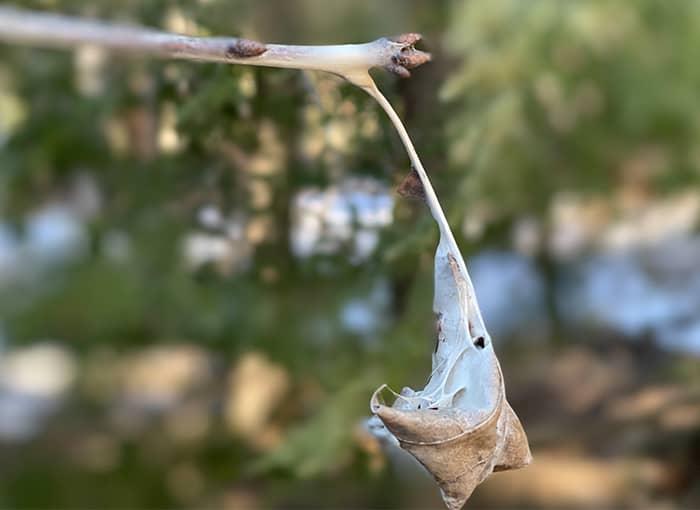History of the browntail moth
The browntail moth is a species of moth that was accidentally introduced into Massachusetts from Europe in the late 1800’s. Browntail moths are now found living in all New England states in addition to New Brunswick and Nova Scotia. The population (for reasons unknown) dropped in the 1920’s and their presence was limited to some islands off the coast of Maine and Cape Cod. However, in the 1990’s these moths established lasting populations along the southern Maine coast and have been a persistent problem for residents ever since.
What do browntail moth caterpillars look like?
Browntail moth caterpillars have dark brown bodies with a broken white strip that runs along each side of them. They have two obvious red spots on their back and are covered in toxic, barbed hairs. These troublesome caterpillars grow to about 1.5 inches in length.

Adult browntail moths have snow white wings, tufts of dark brown hair on the tips of their abdomens, and have a wingspan that is approximately 1.5 inches.
Browntail moth lifecycle
Browntail moths produce one generation per year and have four life stages- egg, larval, pupal, and adult.
- In the fall (late August, early September) newly hatched larvae (caterpillars) colonies create winter webs in trees or under eaves, picnic tables, decks, patios, or porches.
- There can be 25-400 larvae in each overwintering web.
- In the spring larvae become active and emerge from their webs to feed on newly opened leaf buds. For a time the young larvae may go back into their webs at night, but eventually remain on the tree leaves full-time.
- By late June the larvae have reached their full growth potential and spin cocoons in order to pupate.
- By July the pupae have developed into moths and emerge from their cocoons.
- Then each new female moth lays 200-400 eggs on the underside of tree leaves. They protect their eggs by covering them with brown hairs from their body.
- In the fall the eggs hatch, feed and create their winter webs, thus continuing their lifecycle.
Identifying browntail moth winter webs
Winter webs are normally positioned at the ends of tree branches, are typically two to five inches long, and are created from white silk that has been tightly wrapped around a leaf. Upon closer examination (if that's possible), you may notice that they have white silk tying the leaf petiole (stalk) to the leaf.
These webs are commonly found on Oak trees and also apple, shadbush, cherry, beach plum, and rugosa rose to name a few. While rarer, they may be found on maple, birch and ash but avoid pine and other conifers.

What attracts browntail moths?
Browntail moths are attracted to properties that offer them ample food sources, caterpillars feed on the leaves of oak apple, cherry, hawthorn, and other hardwood trees. They will choose these same trees to create their overwintering webs upon. In addition, the adult moths are strongly attracted to light; outdoor lighting fixtures have the potential to attract these pests to your property.
Are browntail moths dangerous?
Browntail moths are not dangerous, but their larvae (caterpillars) are considered to be a very dangerous pest for two different reasons. First, their bodies are covered in toxic, barbed hairs that easily break off, become airborne, and cause health problems for people. Second, their feeding habits can cause damage to trees and shrubs.
Dangers associated with their barbed hairs include:
- The barbed hairs can cause severe rashes (similar to poison ivy), headaches, and significant respiratory problems.
- Their microscopic hairs remain toxic for 1-3 years.
- The small hairs can easily be stirred up by wind or while mowing, raking, gardening, or sweeping.
- Problems caused by their hairs is worst from May to July (when the caterpillars are most active) but can cause a reaction during any point during the year.
- Their cocoons are filled with their toxic hairs and should be handled/removed only by a professional from your home or property.
Dangers associated with their feeding habits:
- They damage hardwood trees and shrubs.
- Caterpillars like to feed on the leaves of oak, shadbush, cherry, apply, beach plum, and rugosa rose- damaging their young delicate leaves.
- Caterpillar feeding habits can cause reduced plant grown and branch dieback.
- Several years of high caterpillar populations can cause plant death.
- For more information check out our blog!
How do you get rid of browntail moth caterpillars?
When controlling browntail moth caterpillars there are many variables that need to be taken into account to ensure the treatment is successful, including a very small treatment window. Providing treatment to eliminate browntail moth caterpillars is something that should only be handled by an experienced and trained professional. At Pine State Pest, we successfully treat and eliminate populations of browntail moth caterpillars through tree injection and if needed low-level spraying.
Tree Injection
- Insecticides are placed beneath the bark of the tree.
- The insecticides move through the veins of the tree with the sap and concentrate in the tree's leaves.
- This treatment method requires a low-level material for effective results.
- The insecticides used are targeted to only come into contact with feeding caterpillars. With this method, the insecticides are kept away from non-targeted organisms, wildlife, and people.
- As the caterpillars feed they ingest the insecticide and are eliminated.
- Treatment occurs right before leaves on the tree open and the caterpillars become active until the caterpillar cocoons.
- Treatment is completely safe for trees.
- Treatment is easily contained.
Tree injection ensures that young caterpillars are treated before the season begins and is key to controlling this dangerous species.
Learn more about our browntail moth caterpillar control.
Browntail moth prevention tips
Avoiding browntail moth caterpillars, especially coming into contact with their airborne hairs is a difficult task. The best prevention tip is professional control combined with the following helpful tips to minimize exposure.
- Avoid areas that are heavily infested with these caterpillars.
- Dry your laundry inside during the spring and summer months to help to avoid clothing, towels, and sheets from being covered in their barbed hairs.
- If you ever come into contact with these caterpillars or their hairs, change your clothing and take a cool shower.
- In areas that are heavily infested with their hairs wear masks, goggles, long pants, and shirts when performing a task that may stir up their hairs (raking, mowing, and weed whacking).
- Mow, work in the garden, and sweep on damp days when the high moisture levels help prevent the toxic hairs from becoming airborne.
At the first signs of browntail moth caterpillars or their nest on your property contact Pine State Pest Solutions so that one of our professionals can come to your aid and discuss treatment.
